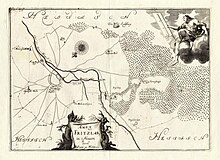Kalbsburg
| Kalbsburg manor | ||
|---|---|---|
|
The mansion from 1911/13 (2015) |
||
| Alternative name (s): | Kalbsburg | |
| Creation time : | around 1197 | |
| Castle type : | Valley slope castle | |
| Conservation status: | receive | |
| Standing position : | Local nobility | |
| Place: | Kalbsburg, Großenenglis | |
| Geographical location | 51 ° 5 '40 " N , 9 ° 16' 5" E | |
| Height: | 230 m above sea level NHN | |
|
|
||
The Kalbsburg is a former manor in the district of Großenenglis of the city of Borken in the Schwalm-Eder district in northern Hesse . It is located on the northern edge of the Großenengliser Platte , the hill above the Ederebene , 4 km south of Fritzlar .
history
The first written mention of the place took place in 1197, when Pope Celestine III. the Spieskappel monastery confirmed income from "Bunebach" (not yet called Kalbsburg at that time). In 1320 Fritzlar Abbey granted the monastery further fiefs there. In 1386 these possessions belonged at least partially to the Haina monastery .
After the decisive victories of the Hessian Landgrave Ludwig I over Archbishop Konrad III. of Mainz in the Mainz-Hessian War of 1427 in the battles near Großenenglis (July 23, 1427) and near Fulda (August 10, 1427), the Archdiocese of Mainz and its feudal men in Northern Hesse lost large parts of their property to the Landgraviate of Hesse , including Gut Hohenenglis. As early as 1431, Landgrave Ludwig I had a watchtower built on the Hessian border with Fritzlar in Mainz, in the immediate vicinity of today's Kalbsburg, and included in the Landwehr of his Borken office opposite Fritzlar in Mainz . The waiting room on the Landwehr , which was only demolished after 1757, was initially named "Tower on the Bonebach" after the local settlement of Bunebach (Bonebach); The name Kalbsburg has only appeared since the middle of the 16th century.
His grandson Ludwig II gave this watchtower to Philipp von Borken in 1448 and, after his death in 1457, to Henne II von Wehren . In 1497 Landgrave Wilhelm I transferred the Landwehr Tower as a fiefdom to his Borken bailiff, Philipp von Wildungen , and his successor expanded this fiefdom with surrounding forests and fields. The von Wildungen expanded the estate and held it until 1596 when Burkhard von Wildungen pledged it to his brother-in-law Melchior von Hanstein and then to his son Kaspar. Kaspar, heavily in debt, ceded the Kalbsburg in 1616 to Landgrave Moritz von Hessen-Kassel , who gave it to his son from his second marriage, Friedrich (from the Rotenburg line ) in 1626 .
In 1644 a privy councilor from Pohlheim and in 1657 his cousin Wilhelm Pohlheim were enfeoffed with the Kalbsburg. The latter sold it to Jost Philipp von Meysenbug . The rest of the story is a series of sales and purchases to landowners who farmed there until 1956. Only the family of the later government director of Kassel Otto von Porbeck (1764–1841), who was raised to imperial nobility in 1779 , held the estate for a long time, from 1778 to 1885.
Today's “mansion” is a villa from the years 1911–1913.
In 1956 the complex came into the possession of the Hessische Landgesellschaft , which then sold the villa, the farm buildings and the former manor house to private owners over the years.
literature
- Historical local dictionary of the state of Hesse (HOL) : Fritzlar-Homberg, p. 169 f.
- Georg Landau : Contribution to local history. "The Kalbsburg" . In: Journal of the Association for Hessian History and Regional Studies . Old series 8 (1860), pp. 392–395.
- L. Wenzel: The yard in the waiting area at Großenenglis . In: Heimatschollen 6 (1926), pp. 3–5.
- Jochen Lengemann: Parliaments in Hesse 1808–1813 . Biographical manual of the imperial estates of the Kingdom of Westphalia and the assembly of estates of the Grand Duchy of Frankfurt (Prehistory and history of parliamentarism in Hesse 7), Frankfurt a. M. 1991, p. 174.
- Werner Ide, From Adorf to Zwesten: Local history paperback for the Fritzlar-Homberg district. Bernecker, Melsungen, 1972
Web links
- "Kalbsburg, Schwalm-Eder district". Historical local dictionary for Hessen. In: Landesgeschichtliches Informationssystem Hessen (LAGIS).






